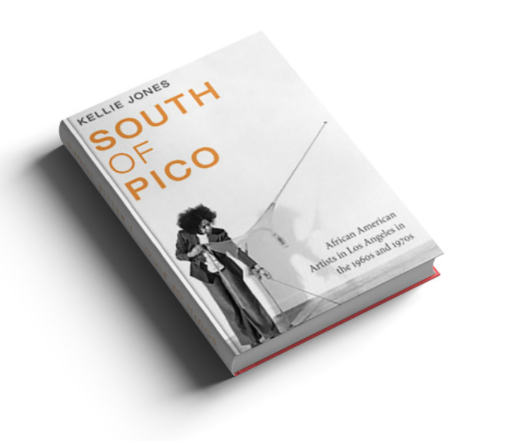South of Pico: African American Artists in Los Angeles in the 1960s and 1970s
South of Pico: African American Artists in Los Angeles in the 1960s and 1970s
by Kellie Jones
Discussion Questions: Introduction - Chapter 1
1. On page 19, the author states that, “This boon examines how artists cast an eye toward what came before and think to what lies ahead through nodes that are at once historical and futuristic.” What are some of the themes you noticed across the artists’ work discussed in chapter 1? How were they similar & how did they diverge?
2. On page 33, Charles White is quoted as saying, “All my life, I have been painting one single painting.” What does he mean by this?
3. What was a Rosenwald Fellowship and how did it support Black artists? (p. 39)
4. How was the library a “creative partner” for artists during this time? (p. 41)
5. Why did many artists of this community harbor such a strong commitment to figurative art?
6. How did the artists discussed in chapter 1 use their work to create community?
7. What were some of the “non-traditional” art spaces the artists used to exhibit their work? Why did they do this & what were the implications? (p. 51)
8. Jones discusses the difference between “fine art” and “applied art”, specifically related to the work of Betty’s Saar. Why is it necessary or useful to make this distinction? (p. 52)
9. How is the concept of migration evident in the work of Melvin Edwards?
Discussion Questions: Chapter 2
1. On page 73, Alma Thomas is quoted as saying, "if everyone were cultured we would have no wars or disturbance. There would be peace in the world." What do you think she meant by this, and do you agree?
2. Why was Noah Purifoy drawn to assemblage as a medium, and how did he integrate the practice into his work with communities? (p. 78-79)
3. Why did Purifoy ultimately move away from the art world? (p. 90)
4. What were some of the reasons that John Outterbridge embraced the art community in Los Angeles? (p. 94)
5. How did the African American history of craft influence Outterbridge's work? (p. 103)
6. How did the work of Betye Saar explore and challenge the notion of "black servitude"? (p. 115-116)
7. Discuss the intersectionality of the Black Power movement and the women's movement. (p. 118)
8. What was the Woman's Building? (p. 120)
9. How did Saar's version of assemblage differ from that of Purifoy and Outterbridge? (p. 125)
10. What are the ways in which Jones claims that African Americans were at the center of the assemblage movement in the post-war art world? (p. 135)
Discussion Questions: Chapter 3
1. Why is it important for Black Americans to be included in the “exhibitionary complex”? (p. 140)
2. Who was Miriam Matthews? What impact did she have on African American representation in the Los Angeles art world? (p. 140-141)
3. How did Black corporations support the arts during this time? (p. 142-144)
4. Jones says that the Black-owned art galleries discussed in this chapter “were counterhegemonic sites that set up networks of belonging” (p. 155). What does she mean by this?
5. On page 166, David C. Driskell is quoted as saying, “I have no dislike for the term black art...We don’t go around saying white art, but I think it’s very important for us to keep saying black art until it becomes recognized as American art.” What does he mean by this statement?
6. How did LACMA do “some things differently” than East Coast museums with regard to exhibitions including African American artists? (p. 170)
7. What are some ways that Samella Lewis contributed to the representation of African American artists in Los Angeles? (p. 172-180)
8. How did Black art collectors of this period differ from their White counterparts? (p. 182)
Discussion Questions: Pages 185-224
1. In the context of works discussed in this reading, what are “remains”? (p. 187)
2. Describe Senga Nengudi’s work Ceremony for Freeway Fets. Why is this work such an important part of her oeuvre?
3. Describe the concept of masking as it relates to the work of Senga Nengudi. (pp. 202-203)
4. What are some of the implications of Nengudi’s use of nylons as sculptural material? (p. 203)
5. How did the work of Houston Conwill represent “aspects of a collective past, specifically a slave past, in commentaries on present-day life”? (p. 219)
6. Describe how the notion of kinship is reflected in the performances of Houston Conwill. (p. 221)
Discussion Questions: Pages 224-276
1. In 1969, David Hammons said, “I feel it my moral obligation as a black artist, to try to graphically document what I feel socially.” How is this desire reflected through his work? (p. 227)
2. What does the spade symbolize in the context of Hammons’ work? (p. 229)
3. Describe the respective approaches to physical violence in the work of Chris Burden and David Hammons. (p. 234-235)
4. What is “social sculpture”? (p. 241)
5. Describe David Hammons’ attitude toward the market with regard to performance art. (p. 243)
6. How did Maren Hassinger’s sculptures inform her performance work and vice versa? (p. 255)
7. Describe the duality of nature and urbanity in the work of Maren Hassinger. (p. 254)
8. Name some contemporary artists who could be considered contextual “heirs” to those discussed in this book.

